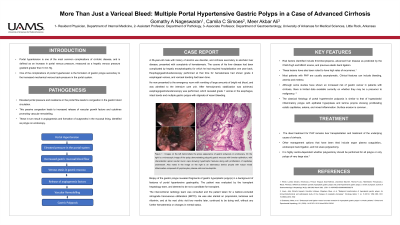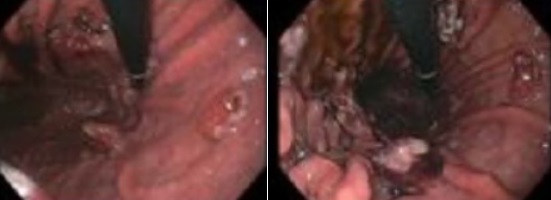Tuesday Poster Session
Category: Stomach
P5119 - More Than Just a Variceal Bleed: Multiple Portal Hypertensive Gastric Polyps in a Case of Advanced Cirrhosis
Tuesday, October 29, 2024
10:30 AM - 4:00 PM ET
Location: Exhibit Hall E

Has Audio

Gomathy A. Nageswaran, MBBS
University of Arkansas for Medical Sciences
Little Rock, AR
Presenting Author(s)
Gomathy A. Nageswaran, MBBS, Camila Simoes, MD, Meer Akbar. Ali, MD
University of Arkansas for Medical Sciences, Little Rock, AR
Introduction: Portal hypertension is the pathological increase in portal venous pressure, most commonly seen as a complication of cirrhosis. The increases resistance to flow in the portal system can result in a variety of changes, such as portal hypertensive gastropathy, erosive gastritis, and gastric varices, and rarely gastric polyps. Here we present the case of a patient with portal hypertensive gastric polyposis, which caused significant bleeding and later required balloon-occluded transvenous obliteration (BRTO).
Case Description/Methods: A 56-year-old male with a history of alcohol use disorder and cirrhosis secondary to alcoholic liver disease presented with complaints of hematemesis. The course of his liver disease had been complicated by hepatic encephalopathy, for which he had required hospitalization one year back. He had also had an episode of hematemesis, and esophagogastroduodenoscopy performed at that time had shown grade 2 esophageal varices, for which variceal banding had been done. He now presented to the emergency room with vomiting of large amounts of bright red blood and was admitted to the intensive care unit. After hemodynamic stabilization was achieved, esophagogastroduodenoscopy was performed, which revealed grade 1 varices in the esophagus, intact bands, and multiple gastric polyps with stigmata of recent bleeding. A biopsy of the gastric polyps was obtained, and histopathological analysis revealed portal hypertensive gastric polyposis. The patient was evaluated by the transplant hepatology team and deemed to be not a candidate for transplant. The interventional radiology team was consulted, and the patient was taken for a BRTO. He was also started on propranolol, lactulose, and rifaximin, and at his next clinic visit two months later, he continued to be doing well without any further hematemesis or changes in mental status.
Discussion: Portal hypertensive polyps (PHP) are a special type of non-neoplastic polyps that are found to be associated with portal hypertension. Elevated portal pressure leads to congestion in the gastric blood circulation, which releases cytokines promoting angiogenesis in the gastric mucosa, resulting in the formation of these polyps. There is still limited data on the management and clinical outcomes of these lesions. Most are symptomatic, but they may be associated with significant bleeding, anemia, or melena. Polypectomy remains one of the preferred options for treatment.

Disclosures:
Gomathy A. Nageswaran, MBBS, Camila Simoes, MD, Meer Akbar. Ali, MD. P5119 - More Than Just a Variceal Bleed: Multiple Portal Hypertensive Gastric Polyps in a Case of Advanced Cirrhosis, ACG 2024 Annual Scientific Meeting Abstracts. Philadelphia, PA: American College of Gastroenterology.
University of Arkansas for Medical Sciences, Little Rock, AR
Introduction: Portal hypertension is the pathological increase in portal venous pressure, most commonly seen as a complication of cirrhosis. The increases resistance to flow in the portal system can result in a variety of changes, such as portal hypertensive gastropathy, erosive gastritis, and gastric varices, and rarely gastric polyps. Here we present the case of a patient with portal hypertensive gastric polyposis, which caused significant bleeding and later required balloon-occluded transvenous obliteration (BRTO).
Case Description/Methods: A 56-year-old male with a history of alcohol use disorder and cirrhosis secondary to alcoholic liver disease presented with complaints of hematemesis. The course of his liver disease had been complicated by hepatic encephalopathy, for which he had required hospitalization one year back. He had also had an episode of hematemesis, and esophagogastroduodenoscopy performed at that time had shown grade 2 esophageal varices, for which variceal banding had been done. He now presented to the emergency room with vomiting of large amounts of bright red blood and was admitted to the intensive care unit. After hemodynamic stabilization was achieved, esophagogastroduodenoscopy was performed, which revealed grade 1 varices in the esophagus, intact bands, and multiple gastric polyps with stigmata of recent bleeding. A biopsy of the gastric polyps was obtained, and histopathological analysis revealed portal hypertensive gastric polyposis. The patient was evaluated by the transplant hepatology team and deemed to be not a candidate for transplant. The interventional radiology team was consulted, and the patient was taken for a BRTO. He was also started on propranolol, lactulose, and rifaximin, and at his next clinic visit two months later, he continued to be doing well without any further hematemesis or changes in mental status.
Discussion: Portal hypertensive polyps (PHP) are a special type of non-neoplastic polyps that are found to be associated with portal hypertension. Elevated portal pressure leads to congestion in the gastric blood circulation, which releases cytokines promoting angiogenesis in the gastric mucosa, resulting in the formation of these polyps. There is still limited data on the management and clinical outcomes of these lesions. Most are symptomatic, but they may be associated with significant bleeding, anemia, or melena. Polypectomy remains one of the preferred options for treatment.

Figure: Endoscopic image of the stomach showing congestion, petechiae and mosaic mucosal pattern, with multiple polyps noted in the fundus and body, during the procedure.
Disclosures:
Gomathy Nageswaran indicated no relevant financial relationships.
Camila Simoes indicated no relevant financial relationships.
Meer Ali indicated no relevant financial relationships.
Gomathy A. Nageswaran, MBBS, Camila Simoes, MD, Meer Akbar. Ali, MD. P5119 - More Than Just a Variceal Bleed: Multiple Portal Hypertensive Gastric Polyps in a Case of Advanced Cirrhosis, ACG 2024 Annual Scientific Meeting Abstracts. Philadelphia, PA: American College of Gastroenterology.

